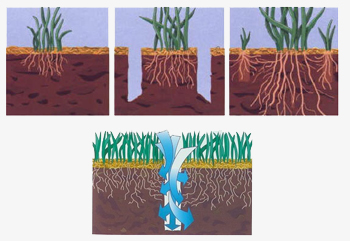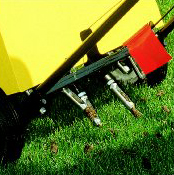|
|||||||||||||||||||||||||

|
|
|
Aeration Process
In most home lawns, the natural soil has been seriously disturbed by the building process. Fertile topsoil may have been removed or buried during excavation of the basement or footings, leaving subsoil that is more compact, higher in clay content and less desirable for healthy lawn growth. The Lawn Institute estimates that over two-thirds of American lawns are growing on compacted soils. Compaction can cause the grass to appear off-color, thinning, and showing signs of stress in high temperatures. Because the grass is stressed, it may be susceptible to disease and insect damage. Compaction occurs primarily in the upper 1 to 1 1/2 inches of soil. Compacted soils have reduced air spaces and more resistance to root growth than non-compacted soils. Compacted soils cause water to puddle and run off. Walking, playing and mowing are forms of traffic that compacts soil and stresses lawns. Rain and irrigation also further compact the soil. The solution is core lawn aeration. Lawn aeration is the process of removing small plugs of soil and thatch from the lawn to reduce compaction and allow aeration of the soil. In essence, you're allowing your lawn to breathe. Without these air pockets, hard-compacted soil suffocates the turf grasses and deprive them of vital water, air, and nutrients. Our specially designed aeration equipment consists of a series cam driven hollow coring tines mounted on wheels. When these hollow tines are rolled over your lawn, they puncture the soil and remove small soil plugs.
The benefits of aeration include :
Soon after aeration, the aeration holes will begin to fill with white, actively growing roots. This is a sign that the turf grass is responding to additional oxygen, moisture, and nutrients in the soil. There is no question that aeration is the most beneficial thing you can do for your lawn. Don't expect miracles from a single aeration though, particularly from lawns growing on extremely poor soils. Lawn experts agree that most lawns benefit from twice annual aeration. Think of regular lawn aeration like a routine checkup with your doctor. Regular maintenance now is preferred over major problems tomorrow! Still have more questions about the aeration process? We've answered nearly 20 questions related to aeration on our Frequently Asked Questions page. If your question still isn't answered, email us at info@Pluggerz.biz. We'll answer your question immediately, and then post it on the site so others may benefit from the information. |
||
Pluggerz Lawn Aeration
P.O. Box 72662
Richmond, Va. 23235
Phone: (804) 218-PLUG

|
Copyright © 2018 Pluggerz Lawn Aeration Site Credits: Media Linkers |




 Aeration 101: "What Is Lawn Aeration And Why Should I Have It Done?"
Aeration 101: "What Is Lawn Aeration And Why Should I Have It Done?" 
 Immediately following aeration, your lawn will be dotted with small plugs pulled from the soil. Within a week or two, these plugs of thatch and soil break apart and disappear into the lawn. As they dissolve back into the soil, the microbes in the plugs will begin to break down the thatch layer. This method of thatch control is preferred over "de-thatching"...an expensive and labor intensive process. If thatch is left unmanaged, it can lead to serious maintenance and pest problems.
Immediately following aeration, your lawn will be dotted with small plugs pulled from the soil. Within a week or two, these plugs of thatch and soil break apart and disappear into the lawn. As they dissolve back into the soil, the microbes in the plugs will begin to break down the thatch layer. This method of thatch control is preferred over "de-thatching"...an expensive and labor intensive process. If thatch is left unmanaged, it can lead to serious maintenance and pest problems.